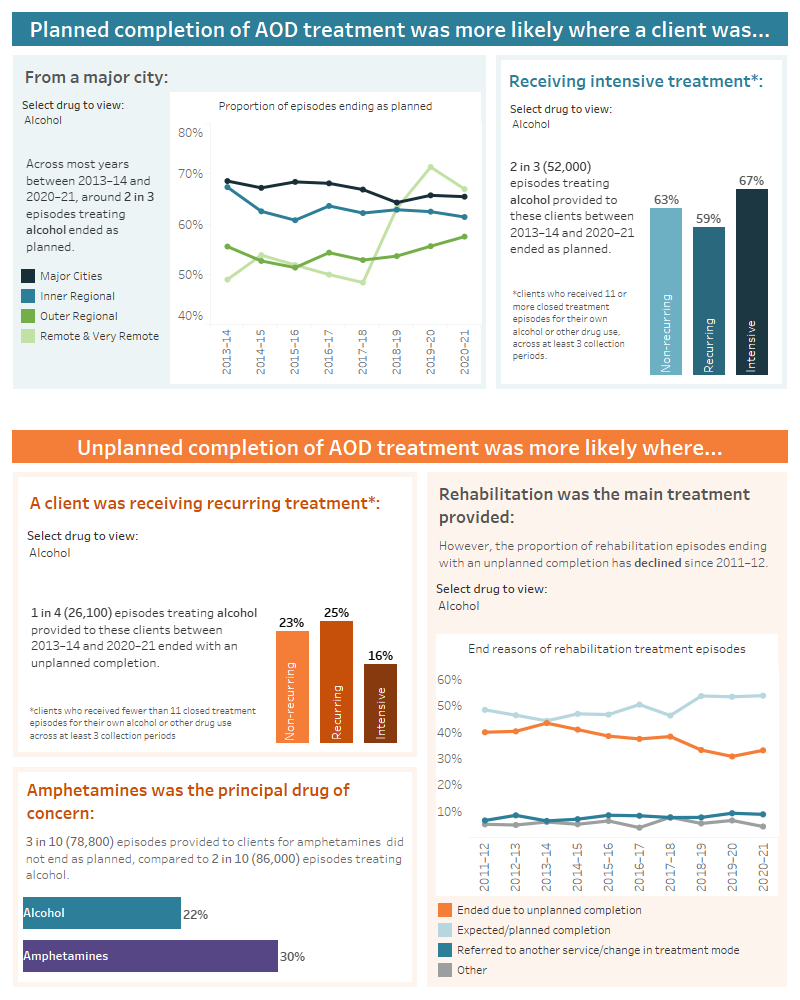Summary
Why examine completion of AOD treatment?
Alcohol and other drug (AOD) use in Australia contributes to a significant burden of physical, psychological and social harms, including chronic disease, mental illness, injury, substance dependence and premature death (AIHW 2018). Support and services for those who use alcohol and drugs, as well as their families and friends, are available through specialist AOD treatment services.
When entering AOD treatment, clients and services identify the clients’ goals and develop a treatment plan accordingly. While treatment objectives vary from client to client, specialist AOD treatment commonly involves multiple treatment episodes over time.
Studies in both Australian and international contexts have found that stable retention in treatment over time is a predictor of more positive treatment outcomes (Lubman D et al 2014). As AOD treatment is often structured around multiple discrete treatment episodes, client retention can be examined through how episodes end. Episodes being completed in line with the client’s treatment plan may indicate more effective engagement between a client and a service. As such, understanding how clients leave treatment may help inform the design and delivery of effective treatment services.
What does this report include?
This report examines the reasons for which clients ended their specialist AOD treatment for a principal drug of concern (PDOC) of either alcohol or amphetamines between 1 July 2011 and 30 June 2021. The report examines whether treatment completion was planned, unplanned or for other reasons (such as referral to another service, imprisonment or death), and whether this varied by:
- Clients’ age and sex
- Clients’ intensity of treatment (such as more treatment episodes over time)
- Treatment characteristics (such as treatment type and PDOC of alcohol or amphetamines)
- Yearly differences.
Three treatment intensity cohorts were defined using the number of treatment episodes a client received over multiple years:
- intensive treatment – clients who received 11 or more closed treatment episodes for their own alcohol or other drug use, across at least 3 collection periods (that is, financial years)
- recurring treatment – clients who received fewer than 11 closed treatment episodes for their own alcohol or other drug use across at least 3 collection periods
- non-recurring treatment – clients who received treatment for their own alcohol or other drug use in fewer than 3 collection periods.
For further information, see How is AOD treatment intensity defined?
This infographic shows key findings from Completion of alcohol and drug treatment in Australia, 2011–12 to 2020–21: differences by drugs of concern and treatment characteristics. Findings are for treatment episodes provided for alcohol or amphetamines as the principal drug of concern. Planned completion of treatment was more likely where a client was receiving intensive treatment or from a major city. Unplanned completion of treatment was more likely where a client was receiving recurring treatment, the episode’s principal drug of concern is amphetamines, or the main treatment provided for an episode was rehabilitation. While rehabilitation episodes were the most likely to end in an unplanned completion, the proportion of rehabilitation episodes ending with an unplanned completion has declined in the last 10 years.

- AIHW (2018). “Impact of alcohol and illicit drug use on the burden of disease and injury in Australia: Australian Burden of Disease Study 2011.” Australian Burden of Disease Study series no. 17. Cat. no. BOD 19. Canberra: AIHW. https://www.aihw.gov.au/reports/burden-of-disease/impact-alcohol-illicit-drug-use-on-burden-disease/summary.
- Lubman D, Manning V, Best D, Berends L, Mugavin J, Lloyd B et al. (2014). “A study of patient pathways in alcohol and other drug treatment: Patient Pathways National Project.” Fitzroy, VIC: Turning Point.


